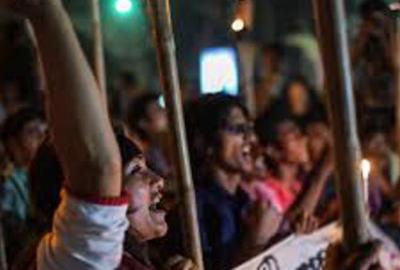 Bangladesh, unlike its neighbour India, has maintained a low profile for the outside world. However, contrary to its image, the political-economic significance of Bangladesh is actually huge. To start with, the country happens to be the eighth most populous nation-state in the world with a vast majority of Muslim population. It has a thriving $26 billion garment industry and the economic growth rates exceed that of India’s. In matters of gender equality, the country has made impressive strides too. And the world is aware of its highly touted, though controversial, investments in micro-finance. These achievements, however, have been overshadowed in the last few years as Bangladesh experiences outbursts of inexplicable violence.
Bangladesh, unlike its neighbour India, has maintained a low profile for the outside world. However, contrary to its image, the political-economic significance of Bangladesh is actually huge. To start with, the country happens to be the eighth most populous nation-state in the world with a vast majority of Muslim population. It has a thriving $26 billion garment industry and the economic growth rates exceed that of India’s. In matters of gender equality, the country has made impressive strides too. And the world is aware of its highly touted, though controversial, investments in micro-finance. These achievements, however, have been overshadowed in the last few years as Bangladesh experiences outbursts of inexplicable violence.
Recently, at some levels, Bangladesh seems to have been motivated by terrorism and some sort of affiliation with radical Islam.
Since 2013, the world is learning increasingly about attacks on whole hosts of minorities, such as secularists, Hindus, LGBT activists, Shia Muslims, among others. In 2016 itself, reports of attacks on Hindus and other religious minorities are crowding our space. The most recent strike happened at Holey Bakery in the diplomatic enclave of Dhaka, in which twenty hostages were killed and many more injured.
For those familiar with the religious and cultural traditions of Bangladesh, and its neighboring Indian state of West Bengal, the society has nurtured a long-standing rationalist tradition along with a secular outlook in most affairs. This worldview dominates the region’s literature and cultural traditions and is, particularly, evident in its multi-religious histories.
Historically, poets, writers, painters, scholars of South Asia, and even those who have traveled through the subcontinent, tended to see the multi-cultural ethos of the Bengali social life. Deeply influenced by works of poets, such as Rabindranath Tagore and Kazi Nazrul Islam, the Bengali culture transcends the sort of political extremism that has long marked states, such as Pakistan and Afghanistan.
However, this starry-eyed view of Bengali regional culture betrays another history, one in which religion, language, and some vision of the future have been intermingled with the violent changes of the twentieth century.
So what explains these recent outbursts? As the New York Times reported back in 2005, is Bangladesh headed for the next “Islamist” revolution?
Such an “Islamist” revolution is unlikely given the vast religious and cultural diversity of the country; though largely a Sunni Muslim country, it has longstanding minority communities of Hindus and Buddhists. Along with the deeply ingrained traditions of secular activism, there is a lively political culture of popular protests and organisation, particularly, led by students of the country.
The country was founded, at least formally, on principles of secularism.
To understand the recent surge of radicalism, we have to have a clear picture of injustices that the people of Bangladesh had to suffer since the first half of the twentieth century. The country’s infrastructure, government services, and funding opportunities have displayed a consistent mark of inequities right since 1947, as it became the eastern half of Pakistan through the partition of the subcontinent.
Though ushered in via the official frenzy of independence and the new-fangled idea of a two-winged Muslim majority, yet secular nation-state of Pakistan, the eastern half witnessed deep social dislocation; a vast majority of civil servants and professionals who were essential for starting a new state migrated to India. Moreover, famine and food shortages throughout the much of the late 1940s and early 1950s coloured the rise of a new East Pakistani Muslim identity and politics.
The process led to two factors that are brewing ever since – a failing and increasingly repressive state apparatus as well as an increasing attachment to symbols and institutions marked by Islam in the rural hinterlands, such as madrasas, particularly those operated privately and depended on foreign funding.
Both before and after 1971, the government of the region has been increasingly less able to manage the needs and aspirations of the people, and particularly in the last five years, has delivered unimaginable repression by arresting common people in the name of national security. Nearly 15,000 people have been arrested in the month of June 2016, as the state responded to attacks by militants.
The attacks by militants have made global headlines, whereas the arrests and state repression have not. Additionally, the state machinery in Bangladesh has proceeded down the complex road of war crimes tribunals and reckonings with the various crimes committed during the 1971 war.
As a small and population dense nation-state with an annual GDP of 150 billion USD, Bangladesh has been subject to the fluctuations of the global labor market. The birth of Bangladesh in 1971, in the aftermath of a civil war and cyclone, coincided with the 1970s oil boom in the Gulf, which prompted approximately 6,000 workers to migrate to the Middle Eastern countries in 1976.
Countries like Saudi Arabia, United Arab Emirates, and Qatar now receive approximately 500,000 – 800,000 Bangladeshi labourers a year, with remittances back to Bangladesh totaling approximately 3.7 billion USD. Currently, an estimated 2 million Bangladeshis live and work in the Gulf. In addition to the money these workers send back home, private foundations and foreign governments of the Middle East regularly fund elements of the sprawling private ‘Quomi’ madrasa system.
The ‘Quomi’ madrasas function outside the state, depends on private sources and is not regulated by any state or inter-state system.
These madrasas answer to no state authority about its curriculum. They stand in sharp contrast with the state-sponsored 'Aliya' madrasas, of which there are several thousand; it prescribes a diverse curriculum in Bangla, English, science and math, and various subjects that lead its graduates to secular universities.
Ironically, after the 1971 war that was associated with the fight for the language of the nation – Bangla – political powers in the country have been increasingly controlled by actors from outside the country. Money flowed in from the Gulf region and brought with it hyper-conservative variants of Islam. On top of it, there has been a contemporary focus on markets for the garments sector that is directed primarily at European and American locales. It is this loss of any sense of localised language and culture at the political level that requires sustained analytical attention to better contextualise the recent surge of radical Islamic feelings in Bangladesh.
There is no doubt that Bengali language and literature as well as other shared cultural practices certainly exist in the mind and heart of Bangladeshis. In fact, the massive swell of protests against the recent killings shows that feelings of solidarity are very much present. But the more important question remains, whether this shared regional culture, and its practices, can successfully confront the powerful vectors of globalisation – whether of garment-centric global capitalism or Saudi-led investment – that shapes much of Bangladesh today.
Neilesh Bose is assistant professor of South Asian history at University of Victoria, Canada. His first book examined the intersections between linguistic identity and Muslim religious community formation in late colonial India. Reprinted with perrmission from author from HERE.
